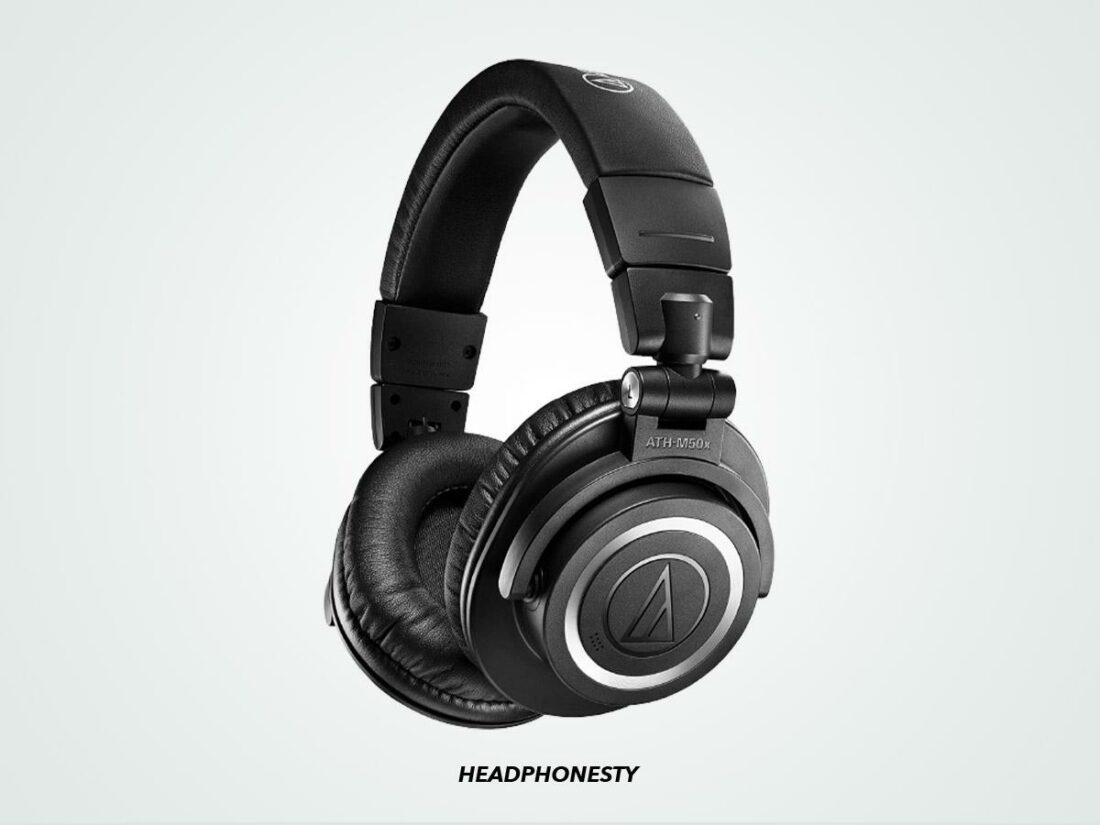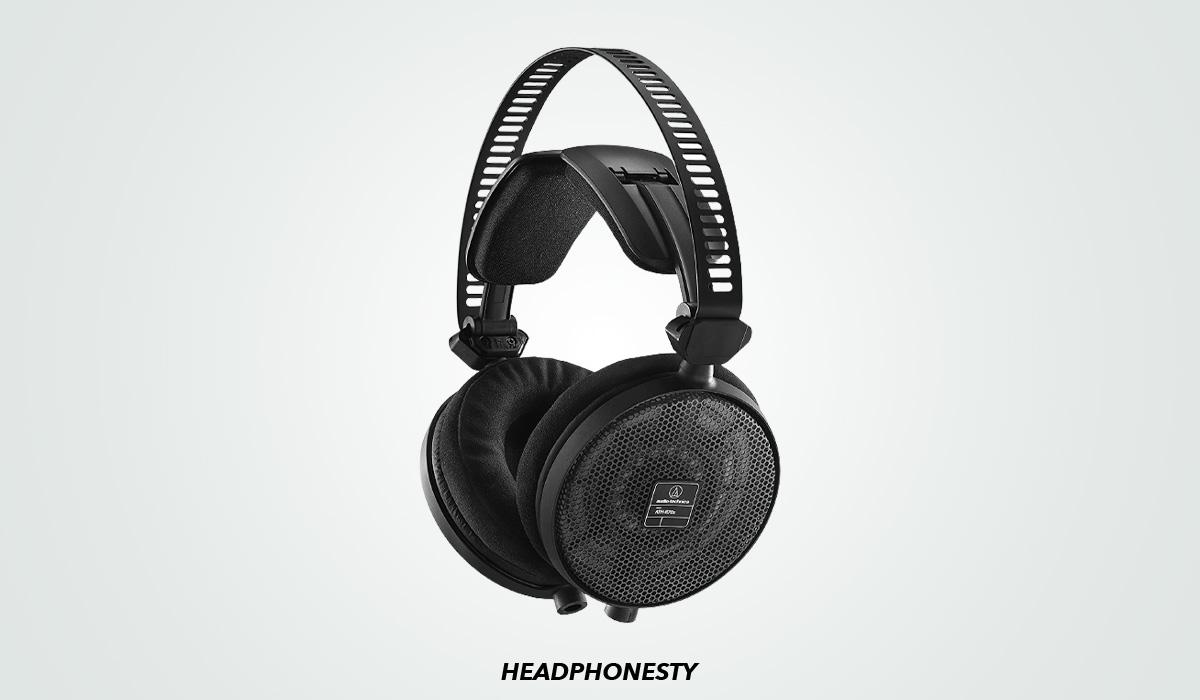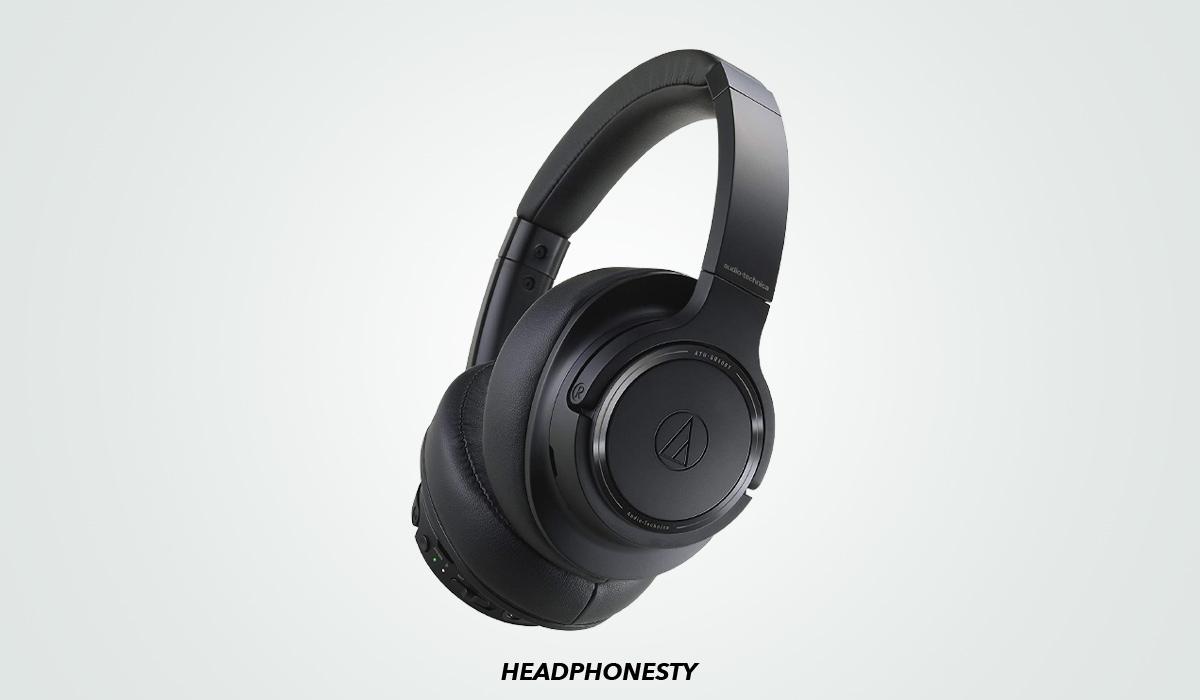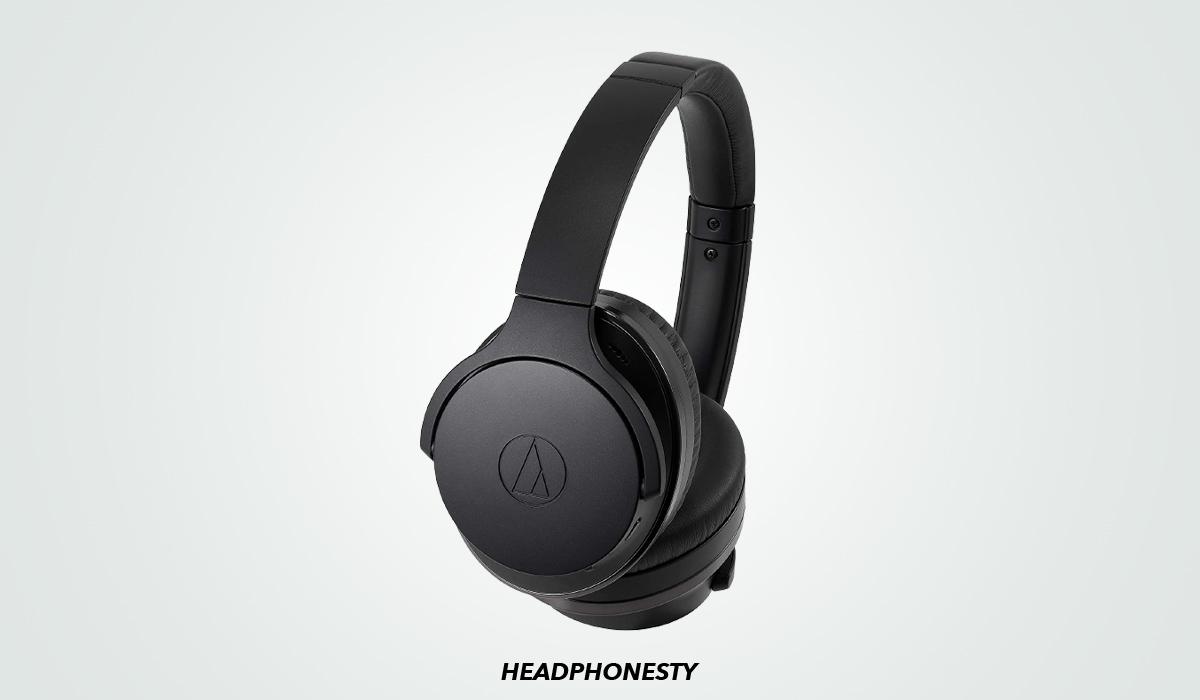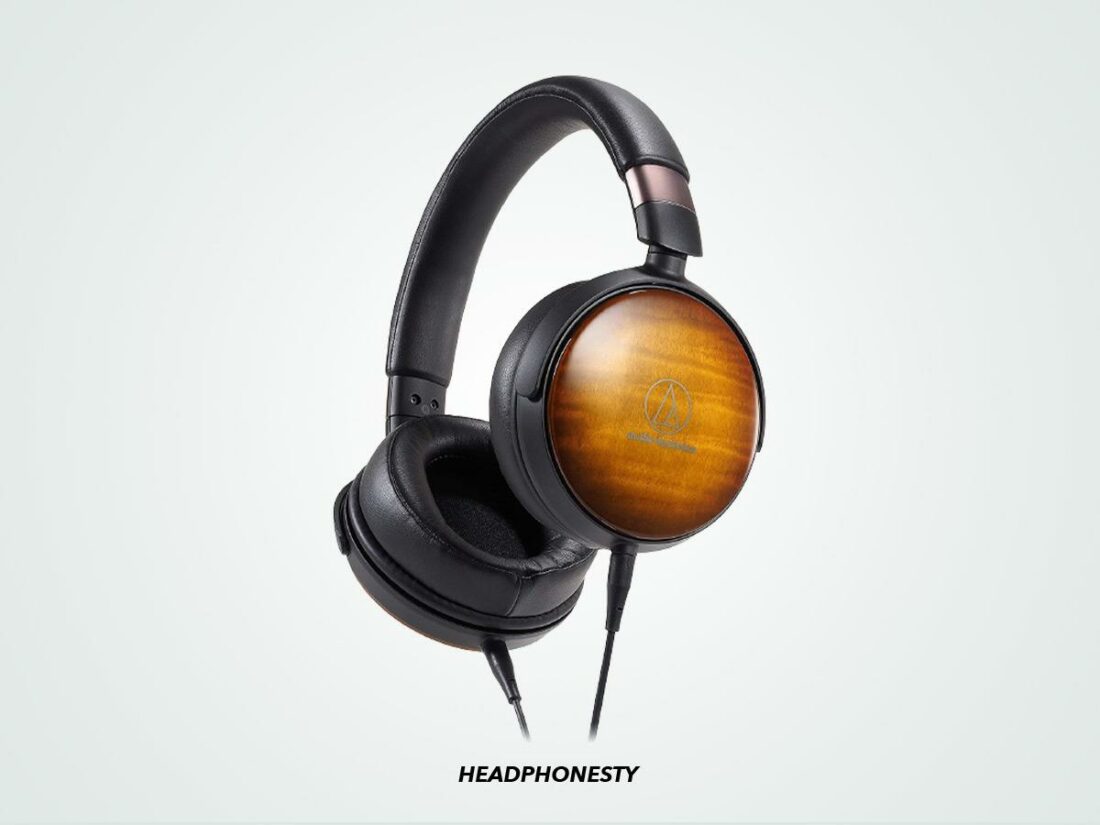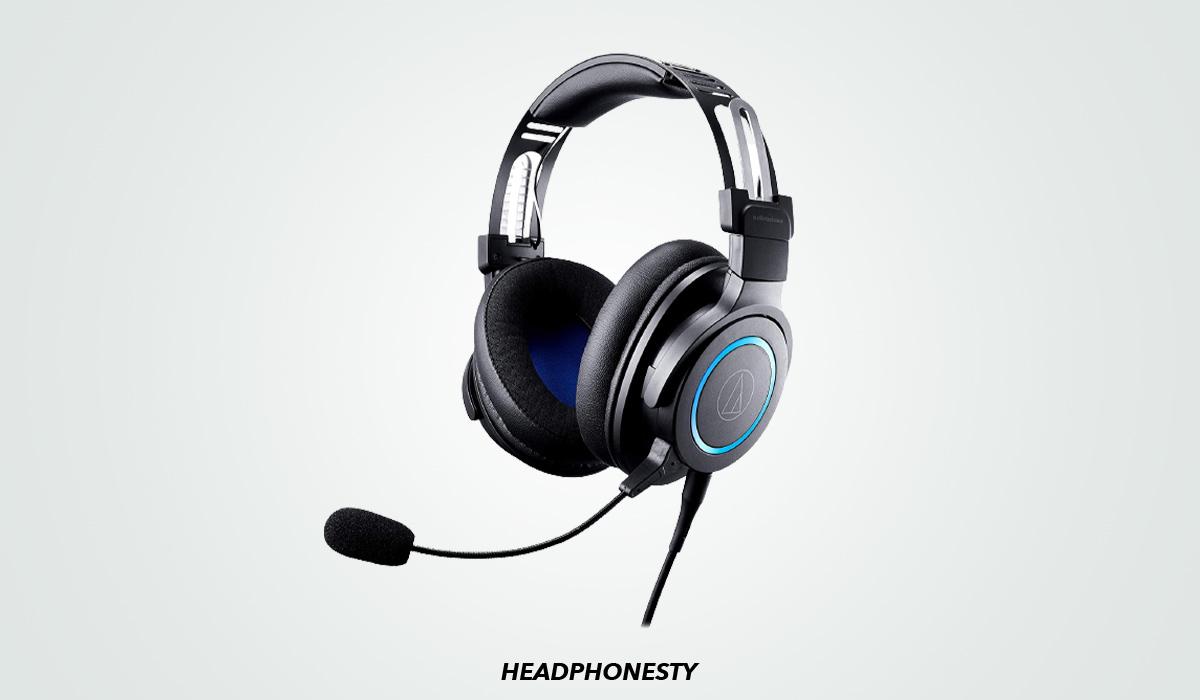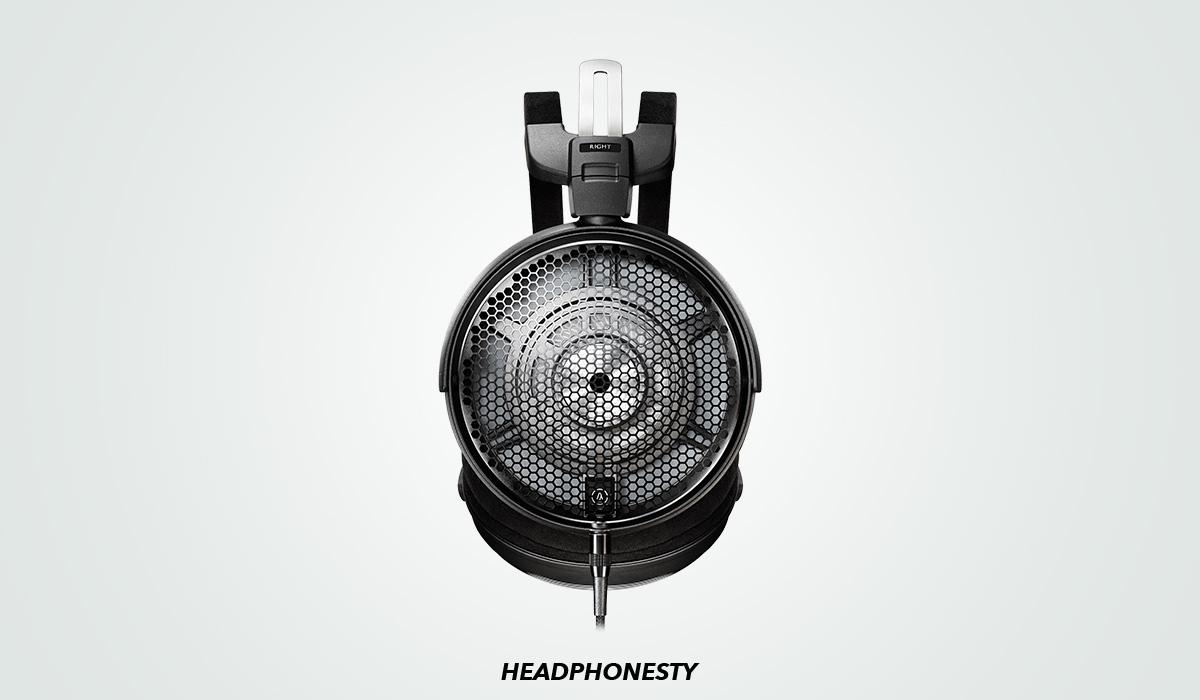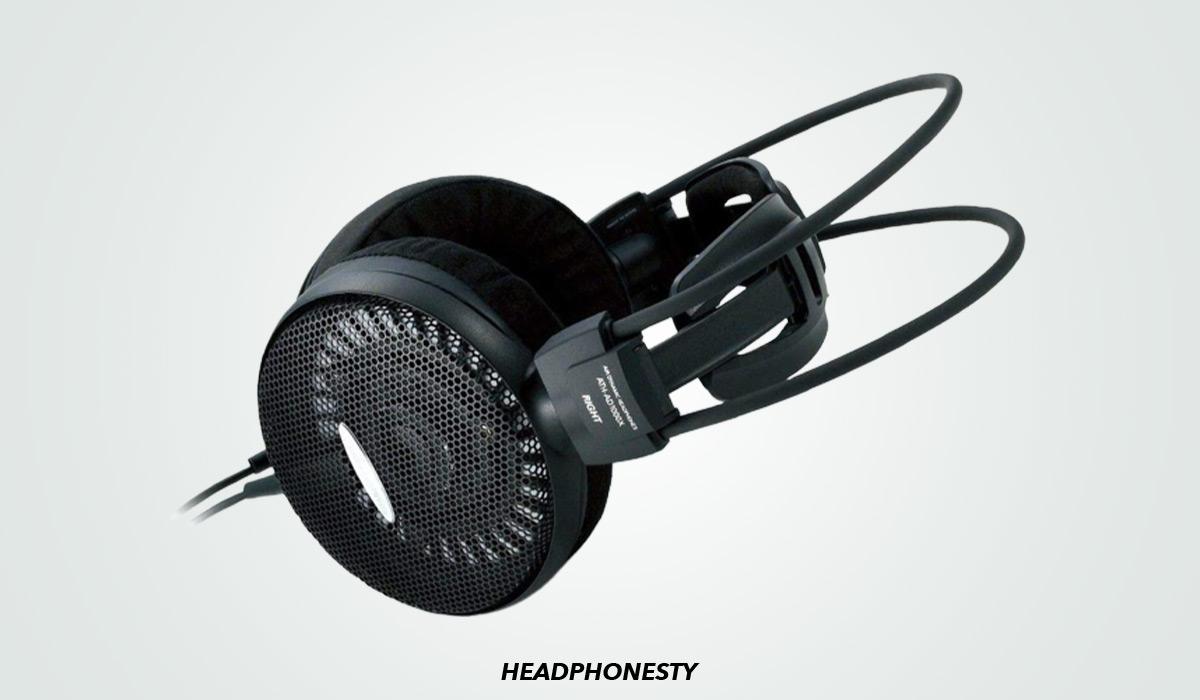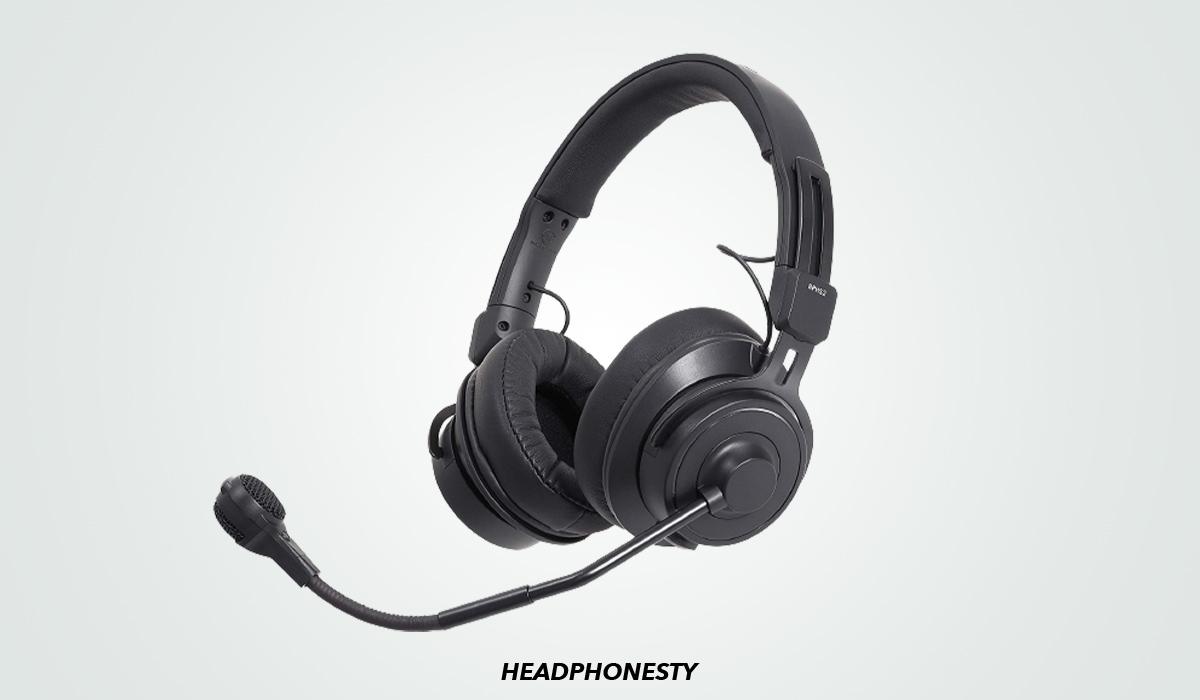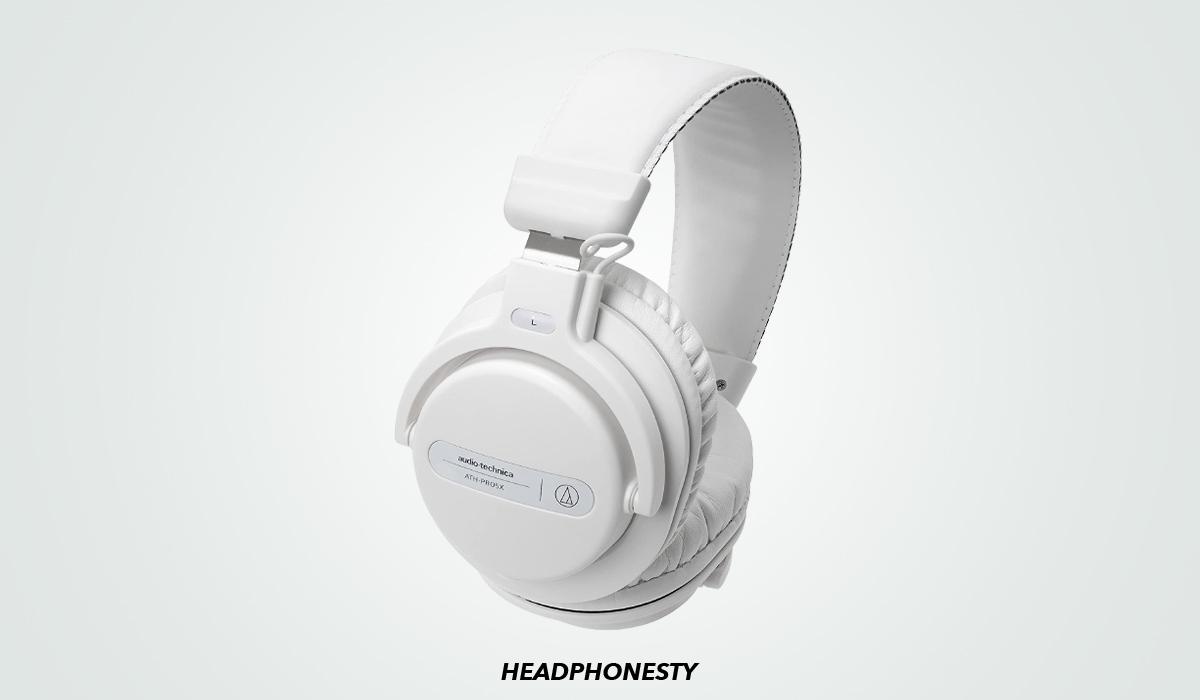How to Choose the Best Audio Technica Over-Ear Headphones
If you wondered whether Audio Technica is a good headphones brand, the answer is a resounding yes. This Japanese company has gained the respect of audio engineers, audio enthusiasts, and casual listeners alike. So, if you’re looking at their headphones as your first (or next) pair, you’re heading in the right direction. Depending on what you want to use them for – be it running, traveling, or audio mixing – the best Audio Technica headphones for you will vary. Audio Technica also now has over 50 headphones in its catalog – making it even more challenging to pick the right pair. Not to worry – we’ve listed several factors below to help you narrow in on your choice of Audio-Technica over-ear headphones.
ATH-M50xBT2
Key features
Connectivity: Wired & wireless (Bluetooth) Type: Closed-back Driver size: 45mm Frequency: 15 – 28,000 Hz Sensitivity: 99 dB Sound signature: Neutral Impedance: 38 ohms Weight: 307 g Mic: Yes
The ATH-M50xBT2 are the company’s latest iteration of the sought-after ATH-M50X. They are a pair of well-rounded headphones suitable for both studio monitoring and casual listening.
For studio
In any case, whether you’re recording, mixing, or monitoring sound inside a studio, the sound quality of your headphones should be the top priority. You should also choose ones with a neutral sound signature to improve sound accuracy.
For travel
If you want headphones to take on the go, picking the ones with smaller sizes and portability features like foldable ear cups and built-in carrying cases is the way to go. Going with active noise-canceling (ANC) headphones will also help eliminate the sounds of engines and your surroundings for a more comfortable trip.
For Gaming
Immersion is the key when it comes to gaming headphones. If you’re an avid gamer and are into multiplayer games, you’d do well to pick a pair with features like surround sound, virtualization, and maybe a built-in mic as well. You should also choose headphones with a warm sound signature to improve the immersion of your in-game sounds.
For calls or office
If you plan on using your headphones at the office or for meetings, pick the ones with a mic and compatibility with the devices and apps you use. We recommend going with our best pick ATH-M50xBT2 – it has Bluetooth, which most consumer devices have, and a high-quality microphone for everyday calls. But since music is still highly subjective, many of Audio Technica products have unique sound profiles. Depending on your preferred sound, you may need to narrow down your choices by considering several factors:
Frequency response
Since human ears can only perceive between 20Hz-20KHz in the frequency spectrum, most headphones stay within this range. However, bass and treble roll-offs and distortions are common problems in average headphones, especially when the sound approaches the 20Hz-20KHz lower/upper limits. That’s why most Audio Technica headphones are made to produce a wider frequency output ranging from 5Hz – 50KHz. Aside from the reduced distortion and roll-offs, the lower bottom limit also helps with immersion since you’d be able to ‘feel’ any sound that plays below 20Hz – which is naturally inaudible to human ears.
Sensitivity
The headphones’ sensitivity determines how efficiently they convert the electronic signals from your phones (or other playback media) into a clean, undistorted sound. Simply put, the sensitivity rating measures how loud a pair of headphones can be at a given signal strength. This is typically measured in decibels per milliWatt (dB/mW) – signifying the volume headphones can reach in relation to the power they draw. Low-sensitivity headphones usually require more power from your device to reproduce high-quality sound. On the other hand, high-sensitivity headphones can operate well with less power, but they tend to distort at high or max volume.
Sound signature
The sound signature is the characteristic or ‘color’ of audio that your headphones produce. Since Audio Technica is a brand that targets audiophiles and music enthusiasts, most of its over-ear models have either a neutral or analytical sound signature. But that’s not to say you can’t find AT headphones with other sound signatures. For example, the ATH-ANC900BT have a V-shaped sound signature with clearly defined bass and treble that appeal to casual listeners. If you’re a bass head, the ATH-WS990bt come with Solid BassTM technology to bring extra punch to the lows. There are also headphones with a bright sound signature like the ATH-MSR7b that deliver crisp and dynamic treble for those who prefer jazz, classical, rock, and folk music.
Open-back headphones
Open-back headphones are designed to allow air to pass through the ear cup and into the back of their drivers. This design allows the audio to sound most natural and clear. Think of it as when you’re attending an orchestra. You’ll see the string instruments at the front, the cellos to your right, and so on. If you close your eyes, you’d be able to visualize the position of those instruments by simply listening to the music. The best open-back headphones can replicate that audio structure and make it as though you are listening to a live performance – this is what the audio community often refers to ‘wide’ soundstage. However, the open-air design also means there won’t be any noise isolation. You will hear your surroundings, and your audio will leak out as well. On top of that, open-back headphones are mostly higher-end (and pricey) enthusiast products.
Closed-back headphones
Closed-back headphones are designed to isolate the sound and prevent outside noise from getting to your ears. However, this means they will have a ‘narrow’ soundstage compared to open-back headphones. The low frequency on closed-back headphones also tends to be more intense due to the resonance within the closed-off ear cup. On the downside, this will make closed-back headphones sound less natural. Wearing them for long periods can also warm up your ears. But if you prefer deep-sounding headphones, the amplified lows on closed-back should be more than welcome. Simply put, impedance is the electrical resistance (measured in ohms) that electronic devices like headphones have in their circuitry. In lay terms, this determines the required voltage from the audio source to power up your headphones. Headphone’s impedance ranges from 8-600 ohms, with the average consumer headphones having 32 ohms impedance. Lower impedance (below 50) means you can get their best performance with less power required. That’s why you can use regular headphones with your smartphones or laptops. But high-impedance headphones like the ATH-R70x (470 ohms) require more power to deliver their best performance. In that case, you’ll need a capable amp to provide enough power to the headphones – otherwise, they can’t put out their best sound. To ensure you’re not getting headphones that your setup or device can’t power, you can check their power requirements with this headphone power calculator. So, if you have a mobile lifestyle and listen to music on the go, wireless headphones are the clear choice. If you decide to get wireless headphones, especially Bluetooth ones, pay close attention to the audio codecs. We highly recommend you go with the ones that support AptX (ATH-SR50BT) or LDAC (ATH-MH50X BT2) since these codecs have the best sound quality. But if you want to get a pair of Audio Technica for your desktop setup at home, wired ones will do you justice, given the sound quality improvements over wireless ones. Audio Technica headphones usually come with two or three high-quality stock cables with a rubber jacket. For example, the ATH-M50x come with a 1.2m straight cable, a 3m straight cable, and a 1.2m coiled cable. They are not the highest-end cable by any means, but they won’t randomly snap off either. Some of their headphones also have a proprietary A2DC (Audio Designed Detachable Coaxial),which is claimed to provide a more stable connection and better sound quality. Generally, you can use these factors to gauge the comfort level of over-ear headphones:
Padding: Since the ear cups or ear pads are the primary contact point with your head, they should be as comfortable as possible. Ideally, leather ear cups with a memory foam pad provide most people with the best seal and comfort. Weight: It’s best to go for lighter headphones <340 grams whenever possible. With less weight resting on your head, you’ll be able to enjoy music for longer without any fatigue or soreness. Adjustability: Some headphones may have too much clamping force by default. Having an adjustable headband will help you find just the right tightness around your head.
Paying that much money for a pair of headphones may sound ridiculous to some people. But as with most things, the price tags on higher-end Audio Technica headphones come with performance and quality that can justify it. For example, in the $100-$200 range, the M50x are nearly unbeatable by their competitors like the Beyerdynamic DT770 Pro or Sennheiser HD599 in terms of bang-for-the-buck ratio. The M50x not only offer a finely-tuned V-shaped sound signature, but they also have:
Foldable ear cups Excellent build quality Three detachable cables Noise-isolating leather ear pads Variety of color options
While you can find the features and options above in the higher-end headphones, no other pair at that price point can match M50x’s offer. These headphones come with wired and wireless connectivity, allowing you to choose between either mode, depending on your setup or device. The good news is: that M50xBT2’s sound quality doesn’t degrade when you use the wireless mode. This is largely because of the LDAC codec that supports hi-res audio. The 45mm drivers deliver precise and accurate bass, transparent mid-range, and well-extended treble that’s comfortable to listen to, even at high volume. We also had no problem identifying the positioning of each instrument and vocals from our test tracks. Moreover, a full charge can give you an impressive 50-hour playback time in wireless mode. But even when you run out of battery, you can get a full charge in only 3.5 hours through the USB-C charging cable or quickly switch to the wired mode. You can also fold the M50xBT2’s ear cups when not in use for easier storage. Plus, you get a leather carrying pouch to store them in. They also have a decent built-in microphone for phone calls or online meetings, which makes the M50xBT2 an excellent option for all-purpose headphones. Unfortunately, the M50xBT2 don’t have active noise-canceling, a super convenient feature if you want to take your headphones traveling or if you frequent noisy areas. That said, if ANC isn’t a must-have feature for you, the M50xBT2 are the clear best-overall Audio Technica over-ear headphones. CHECK LATEST PRICE ON AMAZON
ATH-R70x
Key features
Connectivity: Wired Type: Open-back Driver size: 45mm Frequency: 5 – 40,000 Hz Sensitivity: 99 dB Sound signature: Neutral Impedance: 470 ohms Weight: 210 g
The ATH-R70x are our strong runner-up headphones with the right mix of comfort, sound quality, and overall technical prowess that combine into a nearly perfect listening experience. Despite being tuned as headphones with a neutral sound signature, the R70x have relatively recessed mids and slightly enhanced upper bass, giving them a slightly warm tonality to the otherwise neutral-reference style. The finely-tuned 45mm drivers also deliver pleasant and easy-to-listen mids, which include vocals and string instruments. There’s only little to zero ear fatigue or sibilance, which makes the overall listening experience quite enjoyable. One thing that makes them stand out is sound staging. The R70x feel more immersive than wide – a unique approach for open-back headphones. They feel incredibly open, with an increased perception of height and depth for a better sense of space. They’re not exactly up to par with the higher-end open-back headphones like the HD800S. But they’re comparable, and considering they come at a significantly lower price, this makes the R70x a great option. Comfort is also not an issue with the R70x. They use a set of headband wings to rest the extremely light 210 g headphones on your head. The detachable foam ear pads are also comfortable and breathable, making them suitable for long studio sessions. Despite being very light, these headphones are made from high-quality material that feels durable to the touch. For one, the headband is made of robust metal with perforations that contribute to the lightweight construction. It’s also quite narrow compared to other headbands, which results in better air circulation around the top of your head when wearing the headphones. With a 1,000 mW maximum power input and 99 dB sensitivity, the R70x can deliver a distortion-free sound with the right setup. However, you won’t get the best performance off of these headphones with devices like smartphones and laptops. The included cable is also ridiculously long at 3 meters – so you’ll have to get an aftermarket model if you want a shorter one. CHECK LATEST PRICE ON AMAZON
ATH-SR50BT
Key features
Connectivity: Wired or Wireless Type: Closed-back Driver size: 45mm Frequency: 5 – 40,000 Hz Sensitivity: 100 dB/mW Sound signature: Balanced Impedance: 47 ohms Weight: 262 g
The ATH-SR50BT are Audio Technica’s offer for anyone looking for a pair of excellent-sounding wireless headphones at a competitive price. Their great on-paper spec, which includes a 28-hour battery and active noise canceling, makes the SR50BT our best budget option. If you only want a pair of headphones for listening at home or while traveling, you can use both wired and wireless modes on the SR50BT. The SR50BT have a slight emphasis and sturdiness on the lows and mids, especially apparent with punchy instruments like the kick drums. As a result, the kicks often pop slightly above the mix. The boosted mids also go all the way up to the lower treble, but this doesn’t make the sound tinny or wear out your ears. Considering the SR50BT have ANC and wireless connection, they still provide a decently wide soundstage. The fullness in the midrange allows reverbs and the mic to come through, creating a sense of depth. The headphones’ sense of height also creates separation between instruments, further improving their understanding of space. These make them adequate for listening to music casually but not great for studio or critical listening. Battery life isn’t an issue with the SR50BT – thanks to their 100 dB/mW sensitivity, which works to improve their power efficiency. Our test proved that these headphones live up to the 28-hour claim with 50% volume. Unfortunately, the SR50BT take about 5.5 hours to charge fully. This reduces their portability, especially for power users who use their headphones for hours on end. They also still charge with Micro-USB instead of the more popular USB-C. CHECK LATEST PRICE ON AMAZON
ATH-ANC900BT
Key features
Connectivity: Wired or Wireless Type: Closed-back Driver size: 40mm Frequency: 5 – 40,000 Hz Sensitivity: 103 dB/mW Sound signature: Balanced Impedance: 35 ohms Weight: 263 g
If you’re looking for a more premium taste of wireless over-ears, the ATH-ANC900BT offer a major step-up from our previous recommendation. These headphones have foldable ear cups, which make it simpler to store them in your bag when not in use. Plus, they come with a semi-hard case for safer storage, thus making them convenient for anyone who enjoys bringing their headphones along on all trips. The ANC900BT also have excellent active noise cancelation, which provides just the right amount to negate engine sounds or other loud noises. Also, with ANC turned up to the max (“airplane” mode), the balanced sound signature turns slightly to a warmer tonality. But, as ANC in headphones often results in decreased sound quality (especially when it comes to the bass), this could be viewed as a deliberate method by Audio Technica to maintain good sound quality even with ANC. We also found that the ANC900BT maintained instrument separation and stereo imaging across our test track’s full range of volume levels. Despite being wireless and portable, the ANC900BT deliver punchy kickdrums and basslines – but not overdoing it to the point where it drowns other frequencies. Even so, the mids are distinct and transparent without causing any ear fatigue or sibilance. Coming to battery life, the ANC900BT can last up to 60 hours in wired mode with ANC active and 35 hours with both ANC and Bluetooth. You can fully charge the battery in 5.5 hours with the Micro-USB cable. These specs combined allow you to take them on long trips without worrying about losing your entertainment. Playback control on the ANC900BT is also a breeze with the touch panel on the left ear cup. Everything you’d need to control your media – like play/pause, adjust volume, skip tracks, etc. are all accessible right off the bat. Unfortunately, there’s also no customizable EQ on these headphones, despite them being compatible with the Audio Technica app. Additionally, the touch controls are a bit finicky. Taps and swipes didn’t register as consistently as we would have liked them to – it’s better to use your phone instead to control playbacks. CHECK LATEST PRICE ON AMAZON
Also Good: ATH-WP900
The ATH-WP900 are an excellent alternative for travel headphones. These headphones combine compact size, elegant craftsmanship, and excellent sound quality. Despite having only a wired connection, the WP900 more than make up for it with their bigger 53mm carbon-coated driver. These headphones emphasize forward, upper-midrange that helps accentuate female vocals and string instruments. Do also keep in mind that while the WP900 doesn’t have too much harshness or sibilance, there are occasional sizzle and cracks between 9kHz – 12kHz. What’s even more amazing is that these headphones, at 253 grams, are lighter than even ANC900BT. One downside is that while the ANC900BT have foldable ear cups, the WP900 can only fold flat. Though this isn’t their most ‘portable’ feature, they can rest comfortably around your neck when you’re not playing anything. Unfortunately, the premium comfort features on WP900 also come at a way higher price point than the ANC900BT. CHECK LATEST PRICE ON AMAZON
ATH-G1
Key features
Connectivity: Wired Type: Closed-back Driver size: 45mm Frequency: 5 – 40,000 Hz Sensitivity: 101 dB/mW Sound signature: Slightly bright Impedance: 45 ohms Weight: 250 g
The ATH-G1 are among the few gaming-oriented headphones in Audio Technica’s catalog, and they’re excellent for that purpose. These have a boom mic for crystal-clear team comms and built-in Embody ImmerseTM compatibility. While these headphones are specifically designed for gaming, the superb microphone vocal reproduction makes them suitable for remote working setups and online meetings as well. The mic is a hypercardioid condenser that picks up sounds directly in front and behind it while rejecting most sounds coming from either side. It’s relatively sensitive at -48dB, meaning it can pick up background noises like keyboard or mouse clicks. Luckily, there’s an inline mic mute button for when you’re not talking. The 45mm drivers on the ATH- G1 headset are not meant to sound like studio headphones. The bass is prominent and forward but not to the point where it gets muddy. It almost overwhelms the higher frequencies, forcing you to focus on the lows. In other words, the G1 aren’t the best if you’re looking for a pair of gaming headphones to hear accurate in-game sounds. But what they do is immerse you in your game; safe to say these are our best choice. Add the lightweight build at only 250 g, and the G1 feel super comfortable even when used for hours on end. The included 2m cable allows you to move around more freely. There’s also an inline switch that lets you toggle the microphone on/off without having to open up the settings app on your PC or console. While they are a splendid pair of gaming/video call headphones, the external sound isolation isn’t great. Loud noises around you will drown out quiet sound details from the G1. The inline volume control is also rather slippery to the point where accidental scrolls are very common. CHECK LATEST PRICE ON AMAZON
ATH-ADX5000
Key features
Connectivity: Wired Type: Open-back Driver size: 58mm Frequency: 5 – 50,000 Hz Sensitivity: 100 dB/mW Sound signature: Neutral Impedance: 420 ohms Weight: 270 g
The ATH-ADX5000 are a pair of high-end headphones with an all-around premium experience – from unboxing to listening. They come with a full-on suitcase that ensures the headphones don’t get damaged when they get to you. They’re also super light at only 270g – which is amazing considering the size of their 58mm tungsten-coated drivers. The tungsten coating provides extra stiffness and rigidity to the drivers, which then allows them to reproduce sound with better detail and at higher frequencies. But as expected from headphones of this caliber, the ADX5000 are challenging to drive with, given their whopping 420 ohms impedance. Since they’re a part of the Air Dynamic series, the ADX5000 also have a wide soundstage that does a marvelous job at separating instruments in a 3D audio space. But, while other products in the AD lineup have more of a balanced sound signature, the ADX5000 have a neutral sound that allows you to listen to the purest form of music as if you were present during the recording. Open-back headphones typically face difficulty in retaining tonal balance, which results in harsh vocals and trebles that can get tiresome after some time. But the same cannot be said for the ADX5000, which delivers a nearly life-like experience without being harsh on the ears. Moreover, the ear pads are super soft and cushiony, despite being made from Alcantara and not memory foam. The ear pads are also resistant to heat build-up from wearing them for long periods. They also have a stainless steel headband covered in felt with a big gap in the middle that contributes to the lighter overall weight. You’ll also get a robust adjustment mechanism on each ear cup that feels durable to the touch. Unfortunately, the included cable is a little stiff and hefty. Oftentimes, this can slightly reduce the comfort while moving around with the headphones. It also has Audio Technica’s proprietary A2DC connectors, which are reliable – but are slightly difficult to find replacements for. CHECK LATEST PRICE ON AMAZON
Also Good: ATH-AD1000X
If you prefer a more vocal-heavy sound in your music, you can consider the ATH-AD1000X. Also being a part of Audio Technica’s Air Dynamic (AD) series, the AD1000x have a wide soundstage that brings a nearly life-like listening experience to your ears. However, they sound slightly narrower compared to the previous ATH-AD900x. Yet, the AD1000x still have more detailed and clearer sound than its predecessesor. Even compared to the more premium ATH-AD2000x, both headphones are very similar, especially with how they replicate the strings and vocals. These also won’t compare to the overall neutral and life-like experience the ADX5000 offers, though. CHECK LATEST PRICE ON AMAZON
ATH-BPHS2
Key features
Connectivity: Wired Type: Closed-back Driver size: 45mm Frequency: 15 – 28,000 Hz Sensitivity: 102 dB Sound signature: Balanced Impedance: 38 ohms (headphones) / 550 ohms (microphone) Weight: 250 g
As the flagship headphones from Audio Technica’s broadcasting lineup, the ATH-BPHS2 feature a high-resolution boom microphone with top-notch quality. The microphone in the BPHS2 has a hypercardioid pattern with -57 dB sensitivity and a frequency response of 50 – 14,000 Hz. Thanks to the mic’s polar pattern, the mic is fitting for situations where background noises could be an issue — like in a jam-packed stadium, crowded areas, or even in windy weather. Overall, there’s not much to nitpick about the mic, except perhaps the bass roll-offs, which might require you to place the mic closer to your mouth to incite the proximity effect and avoid sounding too thin. Fortunately, the mic is very stiff yet flexible, so you can direct the mic’s position however you want. You can check how the mic picks up sound in this video. However, the microphone’s impedance is 550 ohms. With that high impedance, the typical 3.5mm audio jack on your PC or laptop won’t have enough power to drive the BPHS2’s mic. If you want to get the most quality out of the BPHS2’s mic, it’s best to use an external audio interface like dedicated soundcards or amps. That’s why they’ve included a 3m long cable with a 6-pin connector on the headphone and a 6.5mm audio jack on the other end. The BPHS2 also have other variants built for different use cases:
BPHS2S offer a single-ear headphone alternative for better direct communication and environmental awareness. BPHS2C have a high-input cardioid condenser microphone with a sleeker design and higher sound fidelity than the hypercardioid dynamic microphone in the standard model. BPHS2C-UT are a variant of the BPHS2C with an unterminated cable (no plug installed) on the other end. It allows you to install any type of audio jack or connector you need.
The BPHS2 are made for a particular purpose: broadcasting. They will do everything you’d need for broadcasting perfectly. But unfortunately, they don’t sound particularly ideal for music or monitoring. These headphones also have a very narrow soundstage that often feels claustrophobic. CHECK LATEST PRICE ON AMAZON
ATH-PRO5X
Key features
Connectivity: Wired Type: Closed-back Driver size: 40mm Frequency: 5 – 35,000 Hz Sensitivity: 100 dB Sound signature: Warm Impedance: 34 ohms Weight: 250 g
If you’re a rookie DJ, the ATH-PRO5X offer solid noise isolation, excellent sound quality, and overall comfortable experience during your live or mixing sessions. The PRO5X have a pair of removable faux-leather ear pads that block out most ambient noise, allowing you to focus on your tune while performing on stage. The lightweight 250 g construction also makes them easier to wear during long sets or mixing sessions. If you want to listen to the crowd while also monitoring your audio, the headband is flexible enough to slightly pull one ear cup behind your ear without worrying the headphones will fall off. The PRO5X sound decent across the board. The high doesn’t get too forceful and maintains just enough details from all the instruments. What stands out from our tests is that the vocal is very forward, as if they’re singing directly in front of you. That said, these headphones seem to be lacking the on-stage feel you’d typically get from other Audio Technica over-ears. The PRO5X have a low impedance at 34 ohms. This means you’ll be able to get their best performance – allowing you to use any DJ booth without sacrificing audio quality. They come with a 3m detachable cable, a shorter 1.2m coiled cable with a 3.5mm audio jack that supports a screw-on 6.5mm connector. This further improves the headphones’ compatibility with various DJ booths and audio devices. Unfortunately, Audio Technica had to cheap out on some materials to keep the cost down. However, it also plays an important role in keeping the headphones light. Plus, the cable is not particularly thick and connected to Audio Technica’s locking mechanism. This could lead to accidental rip-out, which can break the cable. CHECK LATEST PRICE ON AMAZON
